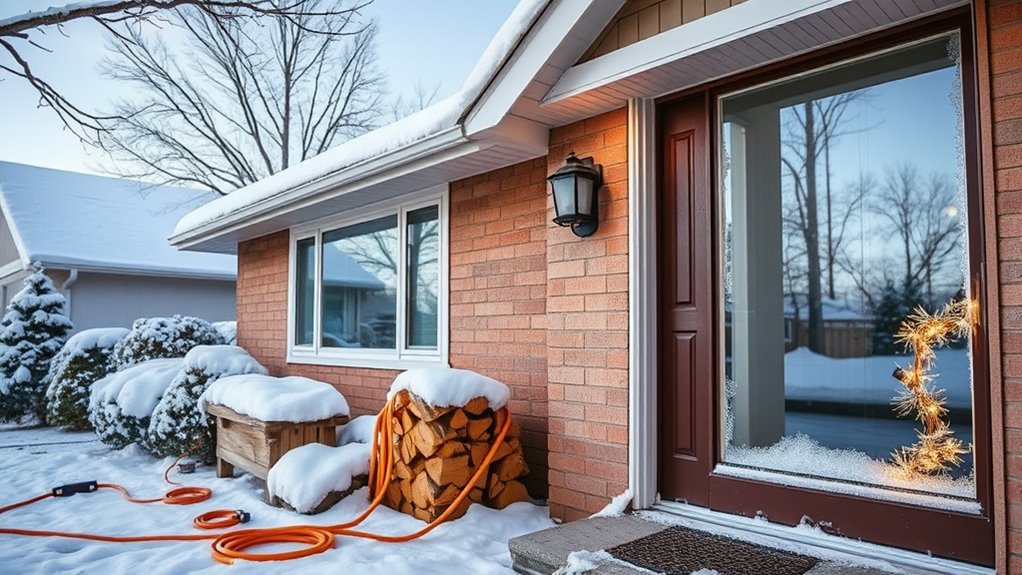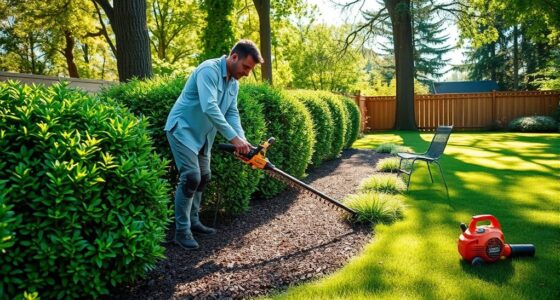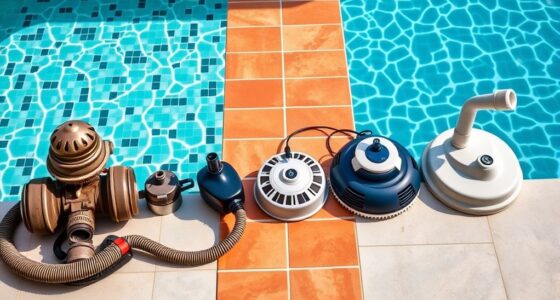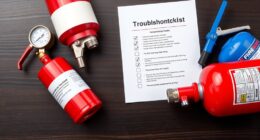To winterize your home, start by sealing drafts around windows and doors with weatherstripping and insulating covers to keep warmth in. Service your heating system to make sure it runs efficiently and replace filters regularly. Protect pipes by insulating exposed plumbing and letting faucets trickle during extreme cold. Inspect and repair your roof and gutters to prevent leaks and ice dams. Don’t forget to prepare emergency supplies and cover outdoor fixtures — tackling these steps now will save you from surprises later.
Key Takeaways
- Seal drafts around windows and doors, and install weatherstripping to prevent heat loss.
- Insulate attic, basement, and exposed pipes to retain heat and prevent freezing.
- Service and maintain your heating system, and check smoke and carbon monoxide detectors.
- Clear gutters, repair roof damage, and trim overhanging branches to protect your home from winter weather.
- Prepare emergency supplies, disconnect outdoor hoses, and store outdoor equipment to ensure safety and readiness.
Seal Drafts and Insulate Windows and Doors
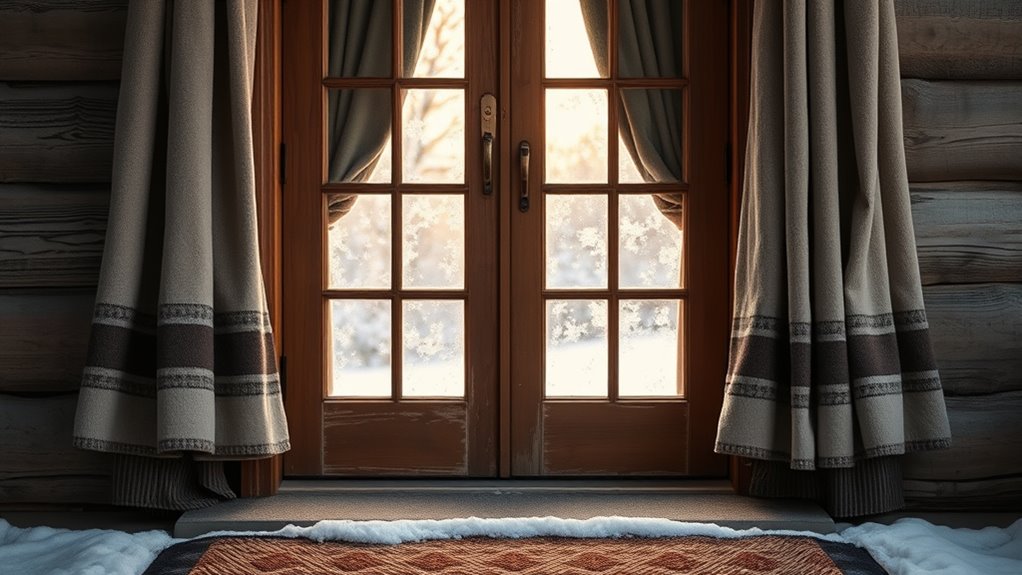
Sealing drafts and insulating your windows and doors is one of the most effective ways to keep warm air inside your home during winter. Start by applying weatherstripping around doors and windows; this simple step can reduce heat loss by up to 15%. Use caulk to seal cracks and gaps around window and door frames, preventing drafts and cold air from sneaking in. Installing door sweeps on exterior doors blocks drafts at the bottom, keeping warmth inside. Cover windows with interior film insulation kits to add a barrier similar to double-pane windows, boosting thermal efficiency. Additionally, insulate basement and attic access points with foam or weatherproofing materials. Incorporating essential oils for winter health, such as eucalyptus or peppermint, into your home can also help improve air quality and promote a cozy atmosphere. Proper home insulation is essential for maintaining energy efficiency and comfort during the cold months. To further enhance your home’s insulation, consider adding thermal curtains which can trap heat and prevent cold drafts. Introducing draft stoppers at the base of doors can also effectively prevent cold air from entering. These steps work together to improve your home’s insulation, making it warmer and more energy-efficient during winter.
Service and Maintain Your Heating System

To keep your home warm and safe during winter, regularly servicing your heating system is essential. Schedule an annual inspection and tune-up of your furnace or heat pump before the cold weather hits. This ensures peak performance and safety. Remember to replace or clean filters every 1 to 3 months to maintain efficient airflow. Use the table below to help you keep track of key maintenance tasks:
| Task | Frequency | Notes |
|---|---|---|
| Inspect furnace/heat pump | Annually, before winter | Check for wear and proper operation |
| Change filters | Every 1-3 months | Use the correct size and type |
| Test detectors | Monthly | Carbon monoxide and smoke alarms |
| Clean vents & chimney | Annually | Prevent creosote buildup |
Regular maintenance keeps your system running efficiently and safely all winter long. Additionally, staying informed about Hyundai Tuning can help you understand how to optimize your vehicle’s performance during colder months, ensuring your car operates reliably in winter conditions.
Protect Pipes and Plumbing From Freezing
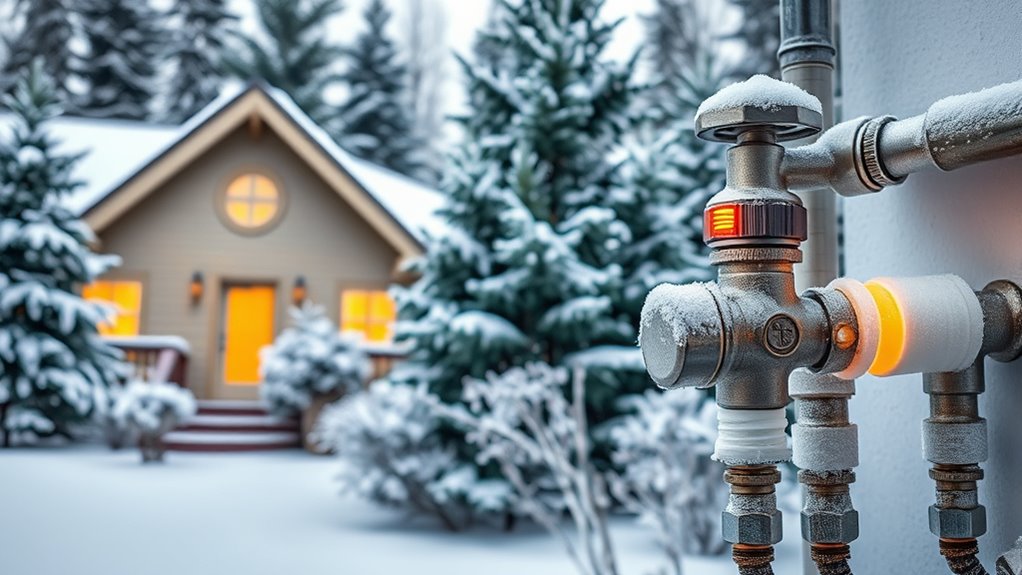
When cold temperatures are forecasted, taking proactive steps to protect your pipes can prevent costly water damage. You should insulate exposed water pipes with foam or fiberglass to prevent them from freezing and bursting. Use heat tapes or heat cables rated for plumbing systems in vulnerable areas, following the manufacturer’s instructions. Self watering plant pots can be a helpful addition to your indoor gardening space, ensuring your plants stay healthy even in colder months when watering routines might be disrupted. Additionally, understanding automation in business can inspire innovative ways to monitor and manage your home’s heating systems remotely, enhancing efficiency and safety. Proper Honda Tuning techniques, like upgrading insulation around your plumbing, can also contribute to overall home winterization efforts. For example, selecting the right headphone jacks can improve your audio experience during winter indoor activities, making your home environment more enjoyable. Exploring remote hackathons can offer opportunities to develop creative solutions for home automation projects, further supporting your winterization goals. Don’t forget to drain outdoor hoses, disconnect them from spigots, and insulate outdoor faucets with faucet covers or insulation sleeves to avoid freezing. Keep your indoor temperature at or above 55°F, and let a slow trickle of water run through faucets connected to uninsulated pipes—this helps prevent freezing. Insulate pipes in unheated spaces like basements, crawl spaces, and garages to further protect your plumbing during extreme cold.
Inspect and Prepare Your Roof and Gutters
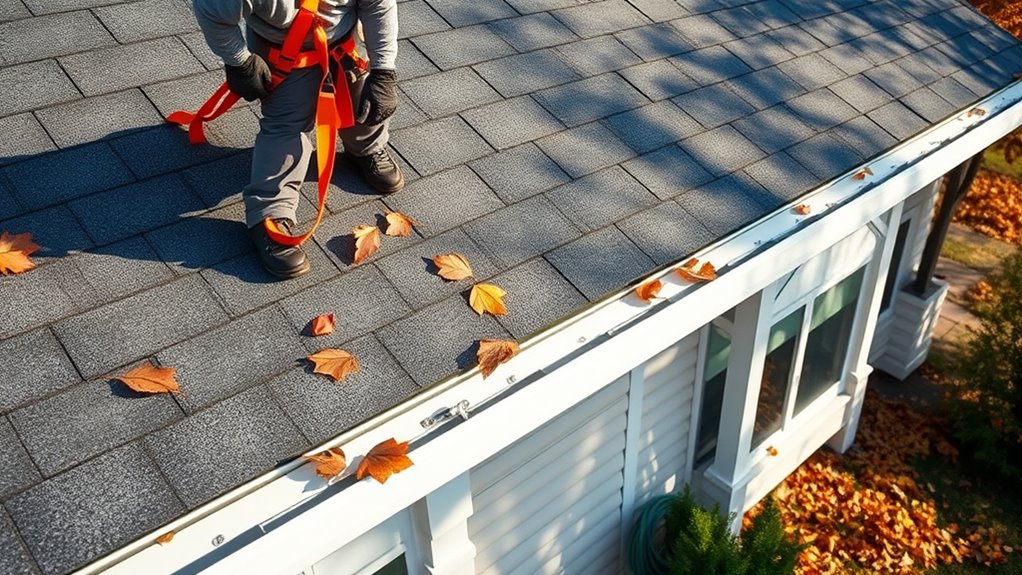
Start by inspecting your roof for missing or damaged shingles and fix any issues to guarantee leaks. Next, clear your gutters and downspouts of leaves and debris to ensure proper drainage and avoid ice dams. Finally, trim overhanging branches that could fall or clog your gutters during heavy snow or ice. To maintain your gutters’ effectiveness, consider regular maintenance and ensure they are free of mold or other spoilage that could impair drainage. Incorporating professional inspections can also help identify potential problems early and keep your home winter-ready. Regularly checking for gutter damage can prevent costly repairs and improve overall function during winter months, especially when using specialized spray tips designed for thorough cleaning and inspection. Additionally, ensuring your gutters are free of blockages can enhance water flow and prevent ice buildup, which is crucial for winter preparedness.
Check for Damage
Inspecting your roof and gutters now is essential to prevent winter damage. Start by checking your shingles for any that are loose, cracked, or missing, as these can lead to leaks during storms. Look for signs of damage or wear that might compromise your roof’s integrity. Proper maintenance of these elements can also help prevent issues caused by weather changes and improve overall durability. Additionally, inspecting your roof regularly can help detect early signs of damage before they become costly repairs. Clear your gutters and downspouts of leaves, pine needles, and debris to ensure proper drainage and prevent ice dams. Trim overhanging branches that could fall and damage the roof or clog your gutters under heavy snow or ice. Also, remove moss or algae buildup on the roof surface, which can retain moisture and weaken shingles. Using wicking materials in your planters can promote better moisture management, which is crucial during winter months. Regularly checking for moisture buildup inside your attic can help identify potential leaks early. Consider installing snow guards or heat cables if needed to prevent snow and ice buildup, reducing the risk of roof damage or leaks.
Clear Debris and Ice
After checking your roof and gutters for damage, it’s time to clear away debris and prepare for winter conditions. Removing leaves, pine needles, and debris from your gutters prevents ice dams and water backup that can cause leaks. Proper maintenance of your roofing system is essential to withstand harsh winter weather. Inspect your roof for damaged or loose shingles, flashing, and valleys to ensure they can withstand winter storms. Trim overhanging branches that could break and damage your roof under snow or ice loads. To reduce weight and prevent water infiltration, clear snow and ice buildup from roof surfaces using roof rakes or blowers. Consider installing snow guards and heat cables if needed to facilitate drainage and prevent ice dams. Properly clearing debris and ice guarantees your roof remains durable and leak-free throughout winter. Additionally, understanding AI-powered virtual reality can help create detailed inspections and maintenance plans for your roof, ensuring thorough winterization. Regularly checking roof integrity and potential vulnerabilities allows for proactive repairs, prolonging your roof’s lifespan and enhancing your home’s winter resilience. Using weather-resistant materials during repairs can further improve your roof’s ability to handle winter conditions. Furthermore, staying informed about latest roofing technology can provide new solutions for winter protection and maintenance.
Insulate Attic and Basement Spaces

Insulating your attic and basement is a crucial step in winterizing your home, as it helps retain heat and lower energy bills. Proper attic insulation can boost heat retention by up to 30%, cutting your heating costs. For the basement, sealing walls and floors with foam board or spray foam prevents cold air from seeping in. Make sure your attic insulation meets the recommended R-value (often R-49 or higher) for your climate zone to maximize efficiency. Before installing insulation, seal air leaks around attic vents and openings to prevent drafts. Additionally, insulating basement access points, like hatch covers and doors, can reduce heat loss by up to 20%. Here’s a quick overview:
| Area | Insulation Tips | Benefits |
|---|---|---|
| Attic | Use R-49 insulation, seal vents | Retain heat, lower bills |
| Basement | Foam board or spray foam, seal leaks | Prevent cold air entry |
Incorporating air sealing techniques can further improve insulation effectiveness by stopping drafts and heat loss.
Prepare Emergency Supplies and Safety Equipment
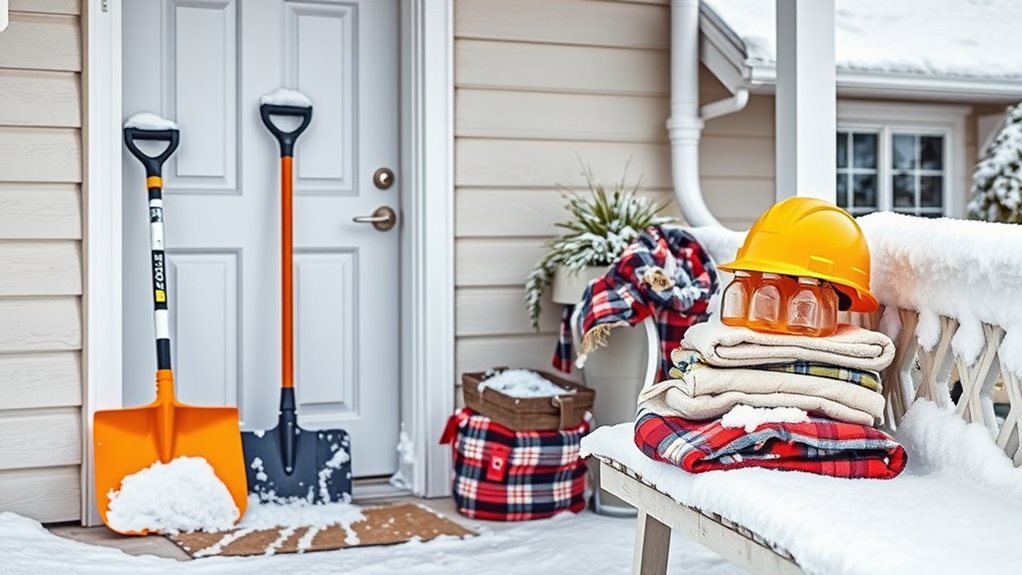
Preparing your home for winter emergencies is essential to stay safe and comfortable during storms or power outages. An emergency kit should include bottled water, non-perishable food, batteries, a flashlight, and a first-aid kit to guarantee safety.
Remember to add blankets, warm clothing, and pet supplies so you stay warm and cozy if outages last longer than expected. Keep extra batteries, portable chargers, and a battery-operated radio accessible to maintain communication and stay informed with weather updates.
Additionally, store basic tools like a snow shovel, ice melt, and jumper cables to handle winter-specific incidents. Regularly review and update your emergency supplies to make sure everything is functional, unexpired, and sufficient for your household’s needs during a winter storm.
Cover Outdoor Fixtures and Store Equipment
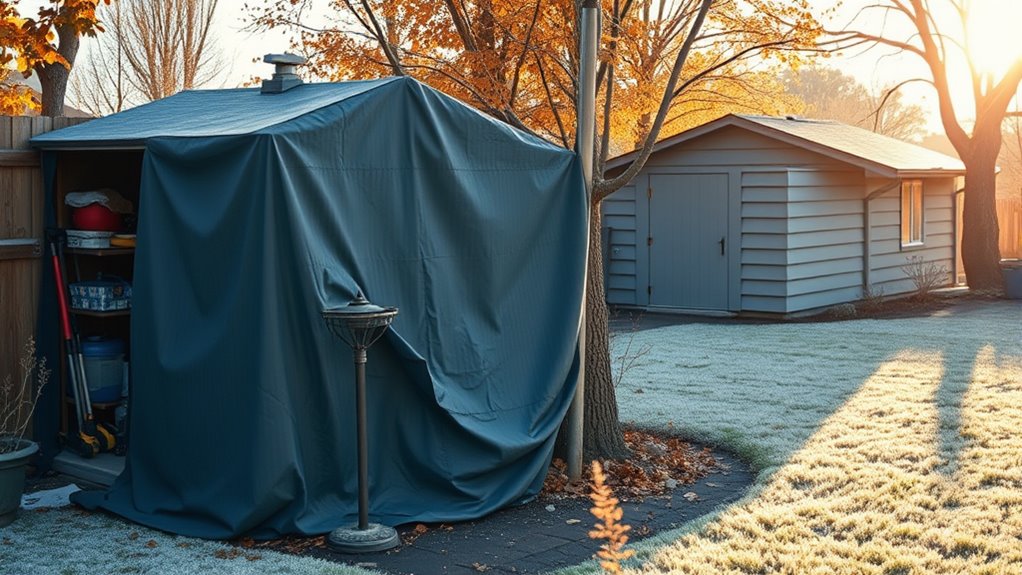
Protecting your outdoor fixtures and equipment is a key step in winterizing your home. Start by disconnecting garden hoses and draining outdoor spigots to prevent freezing and burst pipes. Once the hoses are removed, install faucet covers or insulation sleeves over exterior faucets to shield them from cold damage.
To avoid weather-related deterioration, store outdoor furniture, grills, and equipment inside or under weatherproof covers. Remove propane tanks from gas grills and keep them in a safe, ventilated area away from your home.
Additionally, cover or store outdoor electrical equipment and tools in a dry, sheltered location. Taking these steps helps guarantee your outdoor fixtures and stored equipment remain protected and in good condition throughout the winter months.
Schedule Routine Maintenance and Final Checks
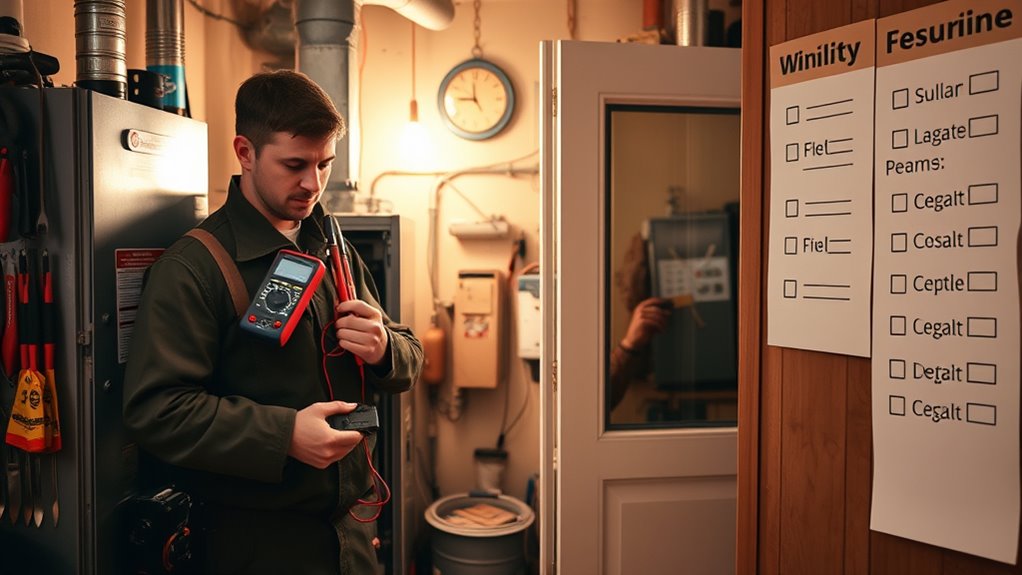
Scheduling routine maintenance and final checks before winter can help prevent costly repairs and guarantee your home stays safe and comfortable. Start with a professional inspection of your heating system to ensure it runs efficiently and safely all winter long.
Schedule winter maintenance now to keep your home safe, comfortable, and cost-efficient all season long.
Next, check and replace or clean filters every 1-3 months to improve airflow and save energy. Don’t forget to flush your water heater every 1-3 years to remove sediment buildup and boost efficiency.
Additionally, inspect your roof for damage, missing shingles, or leaks to prevent water intrusion during storms.
Finally, test smoke and carbon monoxide detectors monthly and replace batteries annually. These steps help you catch potential issues early, ensuring your home is ready and safe for the colder months ahead.
Frequently Asked Questions
How Do You Fully Winterize a House?
To fully winterize your house, start by inspecting and repairing roof shingles, gutters, and flashing to prevent leaks.
Seal windows and doors with weatherstripping and caulking to keep drafts out.
Insulate attic spaces, basement doors, and exterior walls for better warmth retention.
Service your heating system, change filters, and set a programmable thermostat.
Protect pipes by wrapping exposed plumbing and draining outdoor water lines to avoid freezing.
How Do You Close up Your House for Winter?
To close up your house for winter, start by sealing all gaps around windows and doors with weatherstripping and caulk.
Install or replace door sweeps and draft guards to block under-door drafts.
Remove outdoor hoses and insulate or disconnect garden hoses to prevent freezing.
Close and insulate attic and basement openings, and cover unused fireplaces or chimneys with balloons or dampers.
These steps help keep your home warm and save energy all winter.
What Is the Average Cost to Winterize a House?
You’re probably wondering about the average cost to winterize your house. It typically ranges from $500 to $2,500, depending on your home’s size and needed upgrades.
DIY projects like sealing gaps and insulating pipes cost around $100 to $300.
For more extensive work, professional services like attic insulation or chimney cleaning can add $1,000 to $3,000.
What Temperature Should You Winterize Your House At?
Did you know lowering your thermostat to 55°F can cut heating costs by up to 20%?
To winterize your house effectively, set your thermostat to around 55°F when unoccupied to prevent pipes from freezing.
If you’re home, keep it at least 68°F for comfort and safety.
In colder climates, consider maintaining a minimum of 60°F.
Using a programmable thermostat helps balance energy savings and protection.
Conclusion
As you finish winterizing your home, remember that a little preparation now can prevent unexpected surprises later. Sometimes, the smallest fix—like sealing a draft or insulating a pipe—can make all the difference. Coincidentally, the cozy warmth and peace of mind you gain might just be the best reward for your effort. Stay proactive, and you’ll enjoy a safe, comfortable winter, knowing you’ve done everything to protect your home and loved ones from the cold months ahead.
